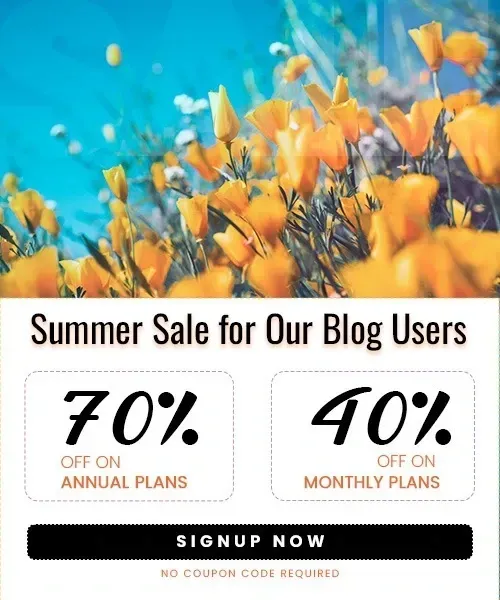How to Promote Your Amazon Store: A Complete Marketing Guide
Last Updated on August 29, 2025 by Himanshu Rawat
Creating an Amazon store is only the first step; how well you promote your Amazon store and market your brands will determine how successful you are. Standing out on Amazon, where there are over 2.8 billion visitors every day, necessitates a multi-channel, strategic approach. This is a thorough guide to marketing your Amazon store to increase sales and visibility.
In this blog, we’ll break down 8 proven strategies to promote your Amazon store, drive traffic, and increase sales.
1. Optimize Your Amazon Storefront and Listings
Improve Product Listings to Increase Conversion and Search
- To increase your product’s visibility in search results and Amazon SEO, incorporate pertinent keywords into the titles, descriptions, and bullet points.
- To stay ahead, use AI tools or keyword research platforms such as Helium 10, Jungle Scout, Ahrefs, and update your keywords frequently based on Amazon’s search trends.

- Invest in captivating product videos and high-quality photos to highlight the features and advantages of your products and boost conversion rates.
- Emphasize your product’s unique selling points and write lucid, compelling descriptions.
- Positive customer reviews have a big influence on search rankings and buyer trust, so promote and highlight them.
Optimize Offers and Prices
- Examine your rivals to make sure your prices are appealing and competitive.
- To attract customers and boost repeat business, provide coupons, discounts, or take advantage of Amazon’s Subscribe & Save program.
2. Make Use of Amazon Advertising
A comprehensive set of tools is available through Amazon Advertising to raise sales, attract targeted traffic, and improve store visibility. Here’s a closer look at how to get the most out of each ad type and optimize your campaigns.
1. Sponsored Products: The Basis for Amazon Advertising
- Simple Entry Point: For new advertisers, Sponsored Products are the best option. These advertisements help customers find your products while they browse or look for related products by showing up in shopping results and on product detail pages.
- Targeting Options: You have the option of manual targeting, in which you choose which products or keywords to target, or automatic targeting, in which Amazon matches your ads to pertinent search terms. For more control, start with automatic targeting to collect data and then fine-tune with manual targeting.
- Pay-Per-Click: This model lets you set and manage your budget because you only have to pay when someone clicks on your advertisement. To optimize your return on investment, modify bids according to performance.
2. Increasing Brand Awareness with Sponsored Brands and Sponsored Display
- Sponsored Brands: You can display your brand’s logo, a unique headline, and several products in these advertisements. They are great for boosting brand recognition and directing traffic to your Amazon Store or a carefully crafted landing page because they show up in premium placements, like above search results.
- Sponsored Display: With Sponsored Display advertisements, you can target customers according to their shopping habits, interests, or even past product views. This includes the ability to retarget potential customers who did not make a purchase during their initial visit.
- Category and Audience Targeting: You can use Sponsored Display to target specific audience segments, competitor products, or categories to make sure your ads are seen by the most relevant consumers.
3. Campaign Optimization: Monitoring and Improving Performance
- Track Performance: Monitor metrics like impressions, clicks, conversions, and ROAS using Amazon Analytics.
- Adjust Budgets & Bids: Increase bids for high performers; lower or pause underperformers.
- Use Automation & AI: Apply automated rules and let Amazon’s AI optimize bids in real time.
- Refine Continuously: Regularly update campaigns based on data and seasonal trends.
Note: Paid campaigns are one of the most direct ways to promote your Amazon store and increase discoverability within Amazon.
3. Use Social Media to Your Advantage
1. Increase External Traffic to Your Amazon Store
- To reach new audiences, post links to your Amazon store and products on social media sites like Facebook, Instagram, TikTok, and Pinterest.
- To spark interest and encourage clicks, produce captivating social media content, such as unboxings, guides, endorsements, and lifestyle photos.
- To precisely target potential customers and send them to specific landing pages or your Amazon listings, use Facebook Ads and other paid social media campaigns.
- Engage with followers, reply to comments, and promote user-generated content to create a sense of community.
2. Make the Most of Your Social Media Strategy
- To start, start with your current network, which includes family, friends, and devoted clients.
- To increase your reach and get more followers, use pertinent hashtags and follow accounts in your industry.
Note: Consistently sharing engaging content is one of the easiest ways to promote your Amazon store outside of the platform.
4. Collaborate with Affiliates and Influencers
- Work together with influencers who share the same values as your target market and brand. These creators can offer genuine product recommendations, fostering trust and increasing your Amazon store’s quality traffic and conversions.
- Make use of the Amazon Influencer Program, which enables influencers to set up customized storefronts where they can show off your goods to their followers. This raises awareness of the product and may result in direct sales.
- Using affiliate links, track the effectiveness of influencer campaigns and adjust your approach by keeping an eye on metrics like click-through rates, conversions, and return on investment.
Why Influencer Marketing Works
It builds trust through social proof and personal recommendations. People are more likely to buy from influencers they follow, making it a powerful way to boost brand awareness and drive sales, especially when the influencer’s niche matches your product.
5. Combine On-Site and Off-Site SEO
Optimize Amazon Listings for Amazon and Google
- Keyword Research: Use tools like Helium 10 or Jungle Scout to find high-volume, relevant keywords—primary, secondary, and long-tail.
- Strategic Placement: Place primary keywords in titles and headers; use others in descriptions, bullet points, backend fields, and image alt-text.
- Backend Keywords: Add hidden keywords in Seller Central to boost search rankings, include synonyms and variations, and avoid repetition.
- Images & Alt-Text: Use high-quality images and keyword-rich alt-text to improve visibility on Amazon and Google.
- Categories & Filters: Choose the right category and detailed attributes to appear in relevant filtered searches.
6. Promote client interaction and loyalty to encourage testimonials and recurring business.
- After a purchase, send a courteous follow-up email or message to express gratitude and ask for candid reviews or feedback. This procedure can be streamlined with the aid of automated tools.
- Review Automation: To improve your chances of receiving high ratings, automate review solicitation using third-party tools or Amazon’s built-in review request features.
- Customer service excellence means answering questions from customers in a timely and helpful manner, fixing problems fast, and going above and beyond to satisfy them. Positive word-of-mouth and repeat business are fostered by exceptional service.
- Loyalty Strategies: For recurring purchases, think about providing discounts, coupons, or loyalty rewards. To keep your brand at the forefront of consumers’ minds, interact with them via Amazon’s messaging system or other channels (such as email newsletters).
7. Increase the Variety of Your Products
Expand Your Catalog in a Strategic Way
- Market research: To find popular products and market gaps, use competitor analysis and keyword tools. Prior to adding new items, examine the competition, demand, and search volume.
- Complementary Products: To increase cross-selling opportunities and average order value, concentrate on launching products that go well with your best-selling items or that suit your brand’s niche.
- Profitability Analysis: Consider possible profit margins, fulfillment expenses, and seasonality when assessing new product concepts. Before making an inventory investment, forecast performance using third-party platforms or Amazon’s analytics.
8. Track performance, evaluate, and adjust

- Analytics Tools: Track traffic, conversion rates, sales, and ad performance with Amazon’s integrated analytics, such as Business Reports and Brand Analytics.
- Keyword tracking: Keep an eye on competitors to spot emerging opportunities or dangers, and track keyword rankings for your listings on a regular basis.
- Determine which titles, pictures, bullet points, and pricing schemes work best by testing them out. Make educated decisions by using data.
- Continuous Improvement: Make time every month to examine your store’s performance indicators, determine what’s effective, and modify your product offerings, SEO, and marketing tactics to ensure continued expansion.
Final Thoughts
It takes constant work to promote your Amazon store. Integrate off-platform techniques like email marketing, social media, and content production with on-platform strategies like SEO and advertisements. Your sales will become more consistent, and you won’t need to use paid promotions as much if you can manage more traffic outside of Amazon.
Begin modestly, see what works, and then increase your efforts. With the correct marketing plan, your Amazon store can grow into a significant source of revenue.
Frequently Asked Questions
1. How can I increase traffic to my Amazon store?
Use Amazon ads, promote on social media, and drive traffic from blogs or YouTube.
2. Can I advertise my Amazon store outside Amazon?
Yes, through Google Ads, Facebook Ads, and influencer marketing.
3. Is it necessary to run Amazon PPC ads?
No, but PPC helps boost visibility and sales faster.
4. How do I get more reviews on my products?
Use Amazon’s review request tool and include review reminders in packaging.
5. Should I build a brand off Amazon, too?
Yes, it helps build loyalty, collect emails, and drive long-term growth.



